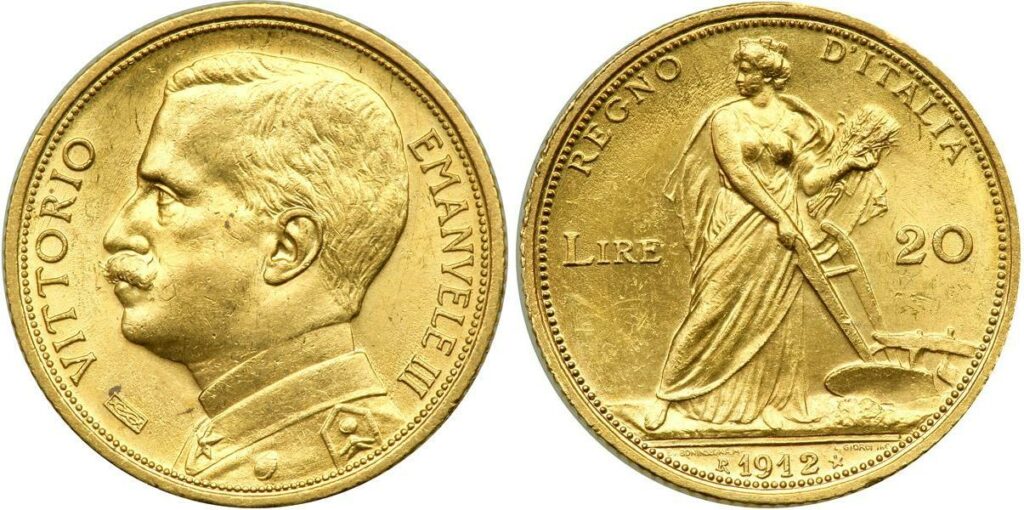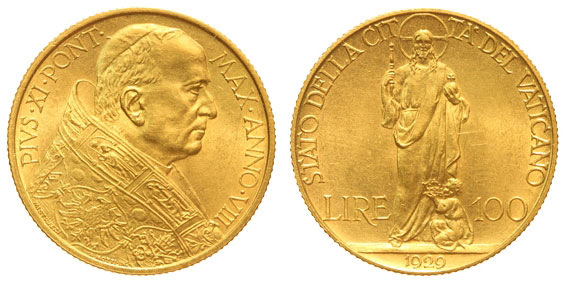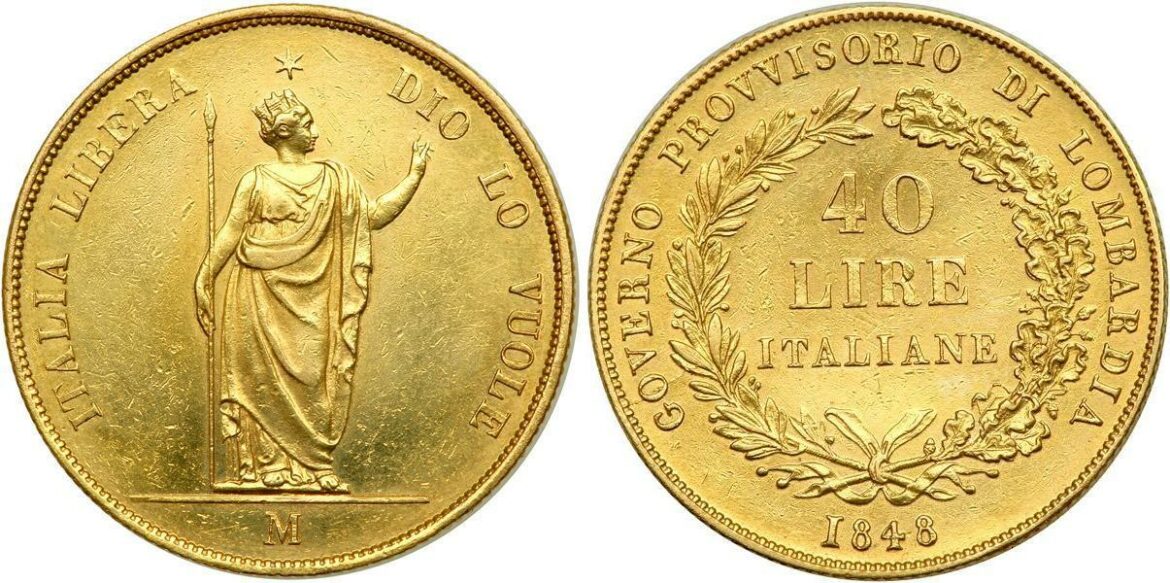In the enchanting realm of coin collection, Italy’s rich historical past and its distinct artistic flair have given birth to a plethora of stunning gold coins that are coveted by numismatists worldwide. These coins are not just pieces of precious metal; they are tangible fragments of a cultural narrative, each holding within its gleaming surface a story of the past. From the ancient Roman aureus to the contemporary commemorative pieces, Italian gold coins offer an extraordinary journey through different epochs and ideologies.
Italy has been a cradle of civilization for millennia, and its gold coins offer a vivid and tangible way to explore this past. For a nation that has seen the rise and fall of powerful city-states, the dramatic transformations of the Renaissance, the political reshaping during Unification, and the turbulent years of the two World Wars, its rich history is forever imprinted in its currency.
As a numismatist, Italian gold coins pique your interest for a multitude of reasons – historical, artistic, and even financial. Not only do they provide a peek into the world of the past, but they are also renowned for their intricate design, aesthetic beauty, and the intrinsic value of the precious metal they contain.
Whether you are a seasoned collector, a history enthusiast, or an investor looking to diversify your portfolio with precious metals, Italian gold coins offer an intriguing mix of history, culture, and value. This article will introduce you to some of the finest Italian gold coins, unveiling the captivating stories they hold, and helping you understand their value in today’s market.
From the dazzling Fiorino d’oro of the Florentine Republic to the legendary Marengo d’oro, Italy’s gold coins have fascinated the world for centuries. As we delve into their fascinating stories, we’ll illuminate not just the beauty of these numismatic pieces, but the vital roles they played in the tapestry of Italy’s history. Join us on this fascinating journey as we explore the world of Italy’s most coveted gold coins.
Italian Lira
The Italian Lira was the official currency of Italy from 1861 until 2002, when the Euro was introduced. “Lira” comes from the Latin word “libra,” which means pound, and the term was originally used to denote a pound of silver.

Coins were minted in various denominations, and gold Lira coins were also produced, though these were less common than their silver or copper counterparts. The value of the gold Lira varied over time, but it typically ranged from 10 to 100 Lira.
Here are some key features and designs of Italian Lira coins:
- Designs: The designs of the Lira coins often represented the current political era of Italy. For example, during the Kingdom of Italy (1861-1946), the coins usually bore the image of the reigning king. During the Italian Republic era (1948-present), coins have displayed various cultural and historical symbols, like famous Italians or important historical events.
- Gold Lira Coins: Gold Lira coins typically came in 10, 20, 40, 50, 80, and 100 Lira denominations. The design of these coins often featured an image of the reigning monarch on one side and Italy’s coat of arms or another national symbol on the other.
- Materials: While the Lira coins were made of various metals including gold, silver, and copper, the gold coins are particularly valued by collectors for their rarity and historical significance.
- Size and Weight: The size and weight of the gold Lira coins varied depending on the denomination. For example, a 20 Lira coin typically weighed about 6.45 grams and had a diameter of 21mm.
Italian Lira coins, particularly the gold coins, are collectible items today. They are valued for their historical significance, design, and gold content. They offer a unique glimpse into Italy’s rich history and heritage.
Vatican Gold Coins
Vatican City, an independent city-state enclaved within Rome, Italy, has its own mint and produces its own coins. The gold coins produced by the Vatican are often of high quality and carry significant value.

Here’s some information on these coins:
- Types: The Vatican has issued various types of gold coins over the years, ranging from commemorative coins to those issued annually as part of the Vatican’s standard coinage.
- Design: The design of Vatican gold coins usually features an image of the current Pope on one side and a religious or Vatican-related image on the other. Over the years, the designs have ranged from images of Saint Peter’s Basilica to depictions of important events in the Catholic Church’s history.
- Papal Change Coins: Some of the most sought-after Vatican gold coins are those minted during a Papal change. These coins often feature a depiction of the outgoing Pope on one side and an image of the sede vacante (the empty seat of the Pope) on the other. Once the new Pope is elected, coins are then issued featuring his image.
- Sizes and Denominations: Vatican gold coins come in a variety of sizes and denominations, often determined by the occasion for which they were minted. Common sizes are similar to those used in other nations’ coinage, such as 1/10 oz, 1/4 oz, 1/2 oz, and 1 oz. Denominations can range from small amounts (e.g., 20 or 50 Euro) up to larger amounts for special issues (e.g., 200 or 500 Euro).
- Value: The value of Vatican gold coins can vary widely. Factors that can affect the coin’s value include the age of the coin, its condition, the rarity of the coin (how many were minted), and the current price of gold.
Remember, if you’re interested in collecting or investing in Vatican gold coins, it’s always a good idea to buy from a reputable dealer and to do your own research on the specific coins you’re interested in.
Venetian Gold Ducats
The Venetian Gold Ducat, also known as the Zecchino, is a gold coin that was first introduced in Venice in the late 13th century. It quickly became one of the most popular and widely used gold coins in the world, owing to Venice’s significance as a global trade power.
Here are some key details about Venetian Gold Ducats:
- Design: The coin typically featured a standing image of Christ in a raised oval (called a mandorla) on the obverse, and the Doge of Venice being presented the ducal cap by the patron saint of Venice, Saint Mark, on the reverse. The design remained fairly consistent throughout the centuries of its mintage.
- Purity and Weight: One of the key reasons for the coin’s popularity was its consistent purity. The Venetian Ducat contained 3.5 grams (0.1125 troy ounces) of 24-karat gold, making it one of the purest gold coins of its time.
- Popularity: Because of its consistent purity and weight, the Ducat became a standard coin in international trade. It was widely copied by other nations and continued to be minted even after the fall of the Venetian Republic in 1797.
- Value: Today, the value of a Venetian Gold Ducat depends on a variety of factors, including its condition, its rarity (certain mintage years are rarer than others), and the current price of gold. It is highly sought after by collectors and historians due to its beauty, its historical significance, and its high gold content.
Napoleonic Italian Gold Coins
During the reign of Napoleon Bonaparte in the early 19th century, a series of gold coins were minted for the Kingdom of Italy, which was then under the control of the French Empire. These coins are often referred to as “Napoleonic Italian Gold Coins” and are highly prized by collectors for their historical significance and intricate designs.
- Types and Denominations: The most common denominations for these gold coins were 20 and 40 Lire, but other denominations such as 5 and 10 Lire were also minted.
- Design: The design of these coins often featured a portrait of Napoleon Bonaparte himself on the obverse side, while the reverse generally displayed the coat of arms of the Kingdom of Italy, which includes the Iron Crown of Lombardy and various heraldic devices symbolizing different regions of Italy.
- Purity and Weight: The 20 Lire Napoleonic Italian Gold coin typically weighs 6.45 grams and is composed of .900 fine gold, while the 40 Lire coin weighs double at 12.9 grams with the same purity.
- Mintage: The Napoleonic Italian Gold coins were minted between 1802 and 1814, during the period when Napoleon was at the height of his power.
- Value: Today, the value of these coins is determined by several factors including their condition, their rarity (certain years of mintage are rarer than others), the current price of gold, and their historical significance. Well-preserved examples, particularly those from rarer years, can fetch high prices among collectors and investors.
- Numismatic Significance: These coins are sought after not only because of their historical significance and intrinsic gold value, but also because they represent a significant period in Italian and European history. Collecting these coins allows numismatists and history enthusiasts to own a tangible piece of the Napoleonic era.
Remember to always authenticate and verify the condition of the coin if you plan on adding it to your collection or investing in it. Always deal with a reputable coin dealer or numismatic professional when purchasing such coins.
Etruscan Gold Coins
Etruscan civilization, which flourished in central Italy from the 8th to the 3rd century BC, is well-known for its vibrant culture, unique language, and significant contribution to the fields of art and architecture. However, the Etruscans were also prolific minters of coins.
Etruscan gold coins are a particularly fascinating aspect of this civilization. They offer valuable insights into Etruscan society, economy, and relationships with other cultures.
In general, Etruscan coins were minted in a variety of metals, including bronze, silver, and gold. However, gold coins are relatively rare, suggesting they were used primarily for large transactions, possibly in international trade or for governmental purposes.
Types of Etruscan Gold Coins
Etruscan gold coins primarily fall into two categories:
- Aurei (singular: aureus): This was a gold coin used throughout the Roman Republic and Empire. The Etruscans, having cultural and economic exchanges with Romans, also used this coin.
- Staters: Originating from Greek coinage, the stater was a standard gold coin circulated in many regions. Etruscan versions often carry designs that reflect a fusion of Etruscan and Greek influences.
Designs and Symbolism
The designs on Etruscan gold coins vary greatly. They could feature gods, goddesses, animals, and various symbols of power. For instance, a popular motif was the ‘Janiform’ head, depicting two faces looking in opposite directions, possibly symbolizing the duality of life and death, a theme common in Etruscan mythology.
The reverse side often had a depiction of an eagle, a sacred animal in Etruscan belief, or other symbols like a horse, a bull, or a sea creature. Sometimes, they featured inscriptions in the Etruscan language, which are of great interest to scholars due to the language’s undeciphered status.
Rarity and Value
Due to the age and historical significance of these coins, they are quite rare and highly sought after by collectors and historians. Their value can be quite high, depending on factors such as the coin’s condition, the rarity of the particular type, and the intricacy of its designs.
